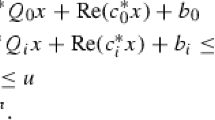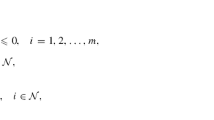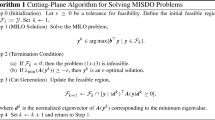Abstract
Complex quadratically constrained quadratic programs (QCQPs) with underlying acyclic graph structures have special interests in some important practical applications. In this paper, we propose a new second-order cone relaxation for complex QCQPs, and prove some sufficient conditions under which the proposed relaxation is tight. Then, based on the proposed second-order cone relaxation, a branch-and-bound algorithm is developed. The main feature of the proposed branch-and-bound algorithm is that some complex variables are selected with their bounds on modules or phase angles partitioned in the branching procedure. Numerical results indicate that the proposed branch-and-bound algorithm runs faster than Baron on randomly generated test instances, and is also effective in solving some publicly available test instances of optimal power flow problems.




Similar content being viewed by others
Notes
Based on the revised definition of \(\arg (z)\in {\mathcal {A}}_{ij}\) introduced in Sect. 1, we have \(0\in {\mathcal {K}}_{{\mathcal {A}}_{ij}}\).
Available at https://sites.google.com/site/burakkocuk/, generated by Kocuk et al. [23].
For each optimal power flow test instances and each \((i,j)\in E\), we have checked that by minimizing \(\text {Re}(X_{ij})\) over \((X,R)\in \text {Feas}({\mathcal {B}}^0)\), we always obtain a positive optimal value.
References
Low, S.H.: Convex relaxation of optimal power flow-part I: formulations and equivalence. IEEE Trans. Control Netw. 1(1), 15–27 (2014)
Low, S.H.: Convex relaxation of optimal power flow-part II: exactness. IEEE Trans. Control Netw. 1(2), 177–189 (2014)
Zimmerman, R.D., Murillo-Sánchez, C.E., Thomas, R.J.: MATPOWER: steady-state operations, planning and analysis tools for power systems research and education. IEEE Trans. Power Syst. 26(1), 12–19 (2011)
Gershman, A.B., Sidiropoulos, N.D., Shahbazpanahi, S., Bengtsson, M., Ottersten, B.: Convex optimization-based beamforming: from receive to transmit and network designs. IEEE Signal Process. Mag. 27(3), 62–75 (2010)
Luo, Z.-Q., Ma, W.-K., So, A.M.-C., Ye, Y., Zhang, S.: Semidefinite relaxation of quadratic optimization problems. IEEE Signal Process. Mag. 27(3), 20–34 (2010)
Zhang, S., Huang, Y.: Complex quadratic optimization and semidefinite programming. SIAM J. Optim. 16(3), 871–890 (2006)
Bose, S., Gayme, D.F., Chandy, K.M., Low, S.H.: Quadratically constrained quadratic programs on acyclic graphs with application to power flow. IEEE Trans. Control Netw. 2(3), 278–287 (2015)
Lavaei, J., Tse, D., Zhang, B.: Geometry of power flows and optimization in distribution networks. IEEE Trans. Netw. Syst. 29(2), 572–583 (2014)
Lehmann, K., Grastien, A., Van Hentenryck, P.: AC-feasibility on tree networks is NP-Hard. IEEE Trans. Power Syst. 31(1), 798–801 (2016)
Sojoudi, S., Lavaei, J.: Exactness of semidefinite relaxations for nonlinear optimization problems with underlying graph structure. SIAM J. Optim. 24(4), 1746–1778 (2014)
Azuma, G., Fukuda, M., Kim, S., Yamashita, M.: Exact SDP relaxations of quadratically constrained quadratic programs with forest structures. J. Global Optim. 82, 243–262 (2022)
**, Q., Tian, Y., Deng, Z., Fang, S.-C.: Exact computable representation of some second-order cone constrained quadratic programming problems. J. Oper. Res. Soc. China 1, 107–134 (2013)
Kim, S., Kojima, M.: Exact solutions of some nonconvex quadratic optimization problems via SDP and SOCP relaxations. Comput. Optim. Appl. 26, 143–154 (2003)
Sturm, J.F., Zhang, S.: On cones of nonnegative quadratic functions. Math. Oper. Res. 28(2), 246–267 (2003)
Ye, Y., Zhang, S.: New results on quadratic minimization. SIAM J. Optim. 14(1), 245–267 (2003)
Grone, R., Johnson, C.R., Sá, E.M., Wolkowicz, H.: Positive definite completions of partial Hermitian matrices. Linear Algebra Appl. 58, 109–124 (1984)
Lu, C., Deng, Z., Zhang, W.-Q., Fang, S.-C.: Argument division based branch-and-bound algorithm for unit-modulus constrained complex quadratic programming. J. Global Optim. 70, 171–187 (2018)
Lu, C., Liu, Y.-F., Zhou, J.: An enhanced SDR based global algorithm for nonconvex complex quadratic programs with signal processing applications. IEEE Open J. Signal Process. 1, 120–134 (2020)
Chen, C., Atamtürk, A., Oren, S.S.: A spatial branch-and-cut method for nonconvex QCQP with bounded complex variables. Math. Program. 165(2), 549–577 (2017)
Mosek ApS 2022. http://www.mosek.com.
Bao, X., Sahinidis, N.V., Tawarmalani, M.: Multiterm polyhedral relaxations for nonconvex, quadratically constrained quadratic programs. Optim. Method Softw. 24(4–5), 485–504 (2009)
Tawarmalani, M., Sahinidis, N.V.: A polyhedral branch-and-cut approach to global optimization. Math. Program. 103(2), 225–249 (2005)
Kocuk, B., Dey, S.S., Sun, X.A.: Inexactness of SDP relaxation and valid inequalities for optimal power flow. IEEE Trans. Power Syst. 31(1), 642–651 (2016)
Author information
Authors and Affiliations
Contributions
C. Lu proposed the main ideas of the enhanced second-order cone relaxation, and designed the main framework of the proposed branch-and-bound algorithm. Z.-B. Deng analyzed the tightness of the enhanced second-order cone relaxation. Y.-H. Liu and Y.-Z. Xu realized all the algorithms proposed in this paper, and carried out the numerical experiments. All authors have checked the correctness of the paper.
Corresponding author
Ethics declarations
Conflict of interest
All authors certify that they have no affiliations with or involvement in any organization or entity with any financial interest or non-financial interest in the subject matter or materials discussed in this manuscript.
Additional information
Cheng Lu’s research was supported by the National Natural Science Foundation of China (No. 12171151). Zhi-Bin Deng’s research was supported by the National Natural Science Foundation of China (No. T2293774), Fundamental Research Funds for the Central University (No.E2ET0808X2), and a grant from MOE Social Science Laboratory of Digital Economic Forecasts and Policy Simulation at UCAS.
Appendix A: The convex hull of \({\mathcal {F}}_{ij}\)
Appendix A: The convex hull of \({\mathcal {F}}_{ij}\)
In this appendix, we prove the following result: If both \((R_{ij},X_{ij})\in {\mathcal {X}}_{ij}\) and \((X_{ii},X_{jj},R_{ij})\in {\mathcal {B}}_{ij}\) hold, then we have \((X_{ii},X_{jj},R_{ij},X_{ij}) \in \text {Conv}{\mathcal {F}}_{ij}\) and \((X_{ii},X_{jj},X_{ij}) \in \text {Conv}{\mathcal {J}}_{ij}\). This result is an extension of some previous results in [17,18,19]. We provide a proof here for the completeness of the paper.
Based on Corollary 5 in [19], we have \({\mathcal {B}}_{ij}=\text {Conv} {\mathcal {T}}_{ij}\). Besides, for a fixed \(R_{ij}\geqslant 0\), the constraint \((R_{ij},X_{ij})\in {\mathcal {X}}_{ij}\) implies that \(X_{ij}\in \text {Conv}{\mathcal {Z}}_{ij}(R_{ij})\). Hence, for any \((i,j)\in E\), the two constraints \((X_{ii},X_{jj},R_{ij})\in {\mathcal {B}}_{ij}\) and \((R_{ij},X_{ij})\in {\mathcal {X}}_{ij}\) imply the following decompositions:
where \((X^t_{ii},X^t_{jj},R^t_{ij})\in {\mathcal {T}}_{ij}\) for \(t=1,\cdots ,r\), \(X^s_{ij}\in {\mathcal {Z}}_{ij}(R_{ij})\) for \(s=1,\cdots ,k\), \(\sum _{i=1}^r \lambda _t=1\), \(\sum _{s=1}^k \alpha _s=1\), and \(\lambda _1,\cdots ,\lambda _r,\alpha _1,\cdots ,\alpha _k\geqslant 0\). Let \( \theta ^s_{ij}=\arg (X^s_{ij})\) and denote \(X^s_{ij}=R_{ij}\textrm{e}^{ \texttt {i} \theta ^s_{ij}}\) for each \(s\in \{1,\cdots ,k\}\). Following (33), together with \(\sum _{i=1}^r \lambda _t=1\) and \(\sum _{s=1}^k \alpha _s=1\), we have the following results:
Moreover, since
we have \((X_{ii},X_{jj},R_{ij},X_{ij}) \in \text {Conv}{\mathcal {F}}_{ij}\).
Next, we show that \((X_{ii},X_{jj},X_{ij}) \in \text {Conv}{\mathcal {J}}_{ij}\). Following (34), we have
Note that since \((X^t_{ii},X^t_{jj},R^t_{ij})\in {\mathcal {T}}_{ij}\) implies that \(R^t_{ij}=(X^t_{ii}X^t_{jj})^{1/2}\), and \(X^s_{ij}\in {\mathcal {Z}}_{ij}(R_{ij})\) implies that \(\theta ^s_{ij}=\arg (X^s_{ij})\in {\mathcal {A}}_{ij}\), we have
Thus, \((X_{ii},X_{jj},X_{ij})\) is in the convex hull of \({\mathcal {J}}_{ij}\).
Rights and permissions
Springer Nature or its licensor (e.g. a society or other partner) holds exclusive rights to this article under a publishing agreement with the author(s) or other rightsholder(s); author self-archiving of the accepted manuscript version of this article is solely governed by the terms of such publishing agreement and applicable law.
About this article
Cite this article
Liu, YH., Xu, YZ., Lu, C. et al. A Second-order Cone Relaxation-Based Branch-and-Bound Algorithm for Complex Quadratic Programs on Acyclic Graphs. J. Oper. Res. Soc. China (2023). https://doi.org/10.1007/s40305-023-00506-z
Received:
Revised:
Accepted:
Published:
DOI: https://doi.org/10.1007/s40305-023-00506-z




